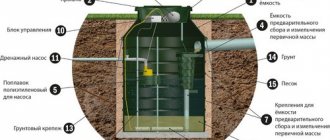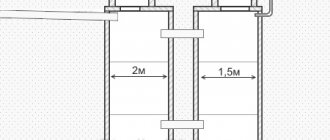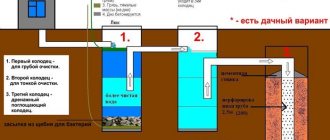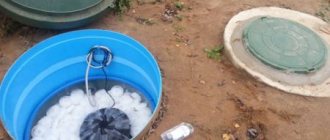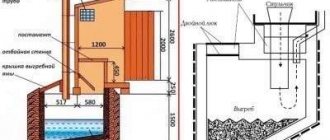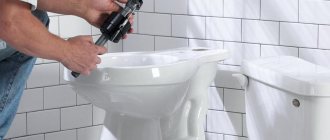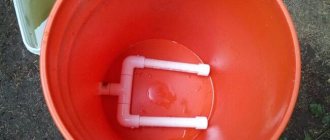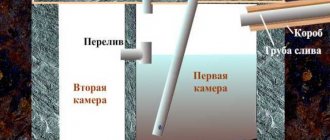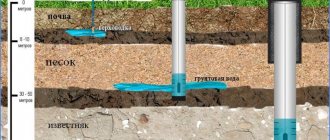Autonomous sewerage for private housing construction is a sign of civilization. But making the system itself, with its internal and external parts, is not all. All waste needs to go somewhere. If the settlement has a central sewer system, then you can connect to it. What if she is missing? In this case, a design such as a septic tank is perfect. Modern models can easily clean all wastewater without polluting the environment.
Today you can find many different models of septic tanks on sale. One of the most popular was called “tank”. Such a system has different capacities, but all models have a similar design. This means that their installation is approximately the same. How to install a septic tank with your own hands? Let's figure it out.
Device and principle of operation
Septic tanks Tank are manufactured in several models, differing in working volume and processing capacity. Regardless of the modification of the “Tank”, the design, principles of operation and installation of each of them are the same, with the exception of some points related to the number of chambers in the septic tank and the nuances of post-treatment.
The body of the “Tank” is made of plastic using a molding method that eliminates the presence of surface seams. The wall thickness is at least 15 mm, and in places where stiffeners are installed (to increase strength and reliability) - 17 mm.
To connect to the sewerage sections, inlet and outlet pipes are installed in the tank, through which wastewater enters and exits the tank. For ease of maintenance, in particular, pumping out bottom sludge with a sewer truck, there is a neck in the upper part of the septic tank.
Inside, the container, depending on the “Tank” model, is divided by partitions into two or three cleaning compartments. After the initial cleaning in the first section, the settled water flows through overflows into the next ones, where it is further purified.
Tank septic tanks are unique in their modular block design: if it is necessary to increase the productivity of the treatment plant, the required number of block modules can be added to it.
After cleaning in a septic tank, the liquid cannot be drained directly into the soil. Additional purification of water is required until it meets the standards of SNiP 2.04.03-85 in an infiltrator or other tertiary treatment facility.
Typical appearance of a septic tank Tank
Something about Tanks
The tank is an autonomous sewer system. It accepts liquid waste that is “supplied” by the bathhouse, toilet, bathroom, and kitchen. Technologically, it is a container consisting of three polypropylene chambers.
The tank will “digest” all waste
It does not require external power sources to operate. During the cleaning process, the water flow flows from compartment to compartment, passing through the filters. To speed up the process, combinations of chemical and biological additives are used.
According to the instructions for the Tank septic tank, the device operates according to the following principle:
- Through the sewer pipeline, the liquid enters the first chamber, where it settles . Gradually, particles of sand and other impurities that cannot be decomposed sink to the bottom, while fatty and organic compounds tend to the surface;
- Relatively clean liquid is poured into the second compartment . Here the organic components decompose. Special bacteria are used;
- At the last stage, moisture passes through the biofilter layers . As a result, 75 percent purification occurs;
- Next, the wastewater enters the infiltrator.
Appearance and design of the infiltrator
Regulatory Requirements
Before installing a septic tank Tank with your own hands, you must carefully read the text of two main documents:
- SNiP 2.04.03-85, which establishes the rules for the installation of external sewerage networks;
- SanPiN 2.1.5.980-00, which sets requirements for the purity of surface waters.
The optimal distance of the septic tank from the house is no more than 6 m, but, at the same time, installation of a septic tank closer than 5 m from the foundation is not recommended due to sanitary and hygienic requirements.
The last restriction is rather advisory in nature, since the “Tank” is a modern treatment plant, during normal operation of which odors characteristic of a septic tank do not appear. At the same time, the shorter the external pipeline, the easier it is for the owner to monitor its operation and the easier it is to avoid blockages. If the pipeline is long, it is necessary to install inspection wells for every 15 m of the pipe length and at places where it turns.
In addition, the following minimum distances must be observed during installation:
- 1 m - to the foundation of any building located on the site;
- 2 m - to the boundaries of adjacent areas;
- 3 m - to the nearest trees;
- 5 m - to the side of a road with heavy traffic;
- 10 m - to the reservoir or the nearest water intake point.
Regulatory requirements for the installation site of a septic tank on the site
It should be noted that the septic tank should be located in such a way that there is free access to it for sewage disposal equipment, or taking into account the fact that the maximum length of the hose used for pumping is 50 m.
Exploitation
In order for the septic tank to work properly, several rules must be followed.
- Do not pour harsh chemicals, chlorine and some detergents into the cleaning system. The bacteria will die.
- Periodically replenish the colony of anaerobes. How and in what quantity to do this is written on the packaging.
- Pump out the septic tank at least once a year
- Clean the biofilter
- If the septic tank is used in a house with temporary residence, then during the absence of residents, it should be preserved.
- Infiltrators must be cleaned every 5 years.
Recommendation! If for some reason chemicals got into the septic tank and the bacteria died, then the colony should be renewed. The colony grows in 20 days. During this time, there may be an unpleasant sewer smell and cloudy water coming out, this is normal.
Preparatory work
Having selected the location for the septic tank Tank with your own hands in compliance with the requirements of regulatory documents, you should proceed to digging pits to accommodate each individual element of the system. The boundaries of the pit are taken according to the dimensions of the container to be installed. It is not allowed to install the container close to the sides of the pit - the clearance between the body and the wall of the pit should be 25 -30 cm.
The nature of the work performed subsequently is determined by the groundwater level. If the groundwater level is located at a depth of more than 2 m, then a sand cushion up to 30 cm thick is sufficient. The sand is poured in layers of 5-10 cm, each layer is compacted.
If groundwater passes above 2 m from the surface of the earth, and water appears at the site of the future location of the septic tank, additional measures must be taken:
- pour a sand cushion at the bottom;
- place a reinforced concrete slab on it or concrete the bottom together with the installation of embedded fasteners;
- Once lowered, the cleaning device is securely attached to the concrete base by means of bandage straps.
The thickness of the sand layer and reinforced concrete slab must be taken into account when calculating the depth of the septic tank.
Photo: example of a finished pit for installing a septic tank Tank
Between the work of digging a pit and installing a septic tank, a significant break should not be allowed: the pit may collapse or fill with rainwater.
Septic tank installation
To install the “Tank” into a pit yourself, you will need the help of several people and the following materials:
- cement;
- sand;
- rope;
- lightweight inorganic sheet insulation (foam is allowed, but not recommended).
The ropes are tied to special technological teeth on the tank body. Before lowering, you must visually check that there is no damage to the container.
Depending on the weight of the specific model, lowering the septic tank into the pit will not be difficult for 2-4 people. To immerse the heaviest cleaning device in the line, for example, Tank-4, the use of lifting equipment may be required.
The container is leveled - by rocking and pouring sand under the bottom, it is installed so that the neck takes on an almost horizontal position. The neck extensions are installed, after which the “Tank” is partially filled with water to check the tightness and compaction of the sand cushion.
Then the “Tank” is uniformly sprinkled with a mixture of cement and sand in a ratio of 1:5 with layer-by-layer compaction to the level of the outlet pipe and its installation. Simultaneously with filling, water should be gradually added to the container so that the water line is always above the filling line - this will prevent the walls from collapsing.
Photo: process of sprinkling during installation
Wastewater treatment device depending on the soil
Leaving the “Tank”, the wastewater has a purification level of up to 80%, therefore discharging it into the soil without additional treatment is not allowed. The same SNiP 2.04.03-85 standardizes the minimum degree of wastewater treatment at 95%.
The installation diagram for a septic tank Tank for different cases involves the installation of various wastewater treatment systems, for example:
- filtration well (column);
- infiltrator;
- filtration field.
Based on the drainage characteristics of the soil and the groundwater drainage line, the installation of one or another system can be effective.
Average or low groundwater level, soil absorption is normal
A universal method of post-purification and disposal of water purified by a septic tank in such conditions is the installation of an infiltrator, which is an elongated rectangular container, in the bottom of which there are many holes through which relatively purified liquid seeps down.
Infiltrators (in most cases several of them are required) must be installed with your own hands in a separate pit dug at a distance of 1-1.5 m from the treatment tank. The device is connected to the septic tank through its outlet pipe, laid with a slope.
With normal drainage characteristics of the soil, the installation of the infiltrator is carried out on a crushed stone fill with a thickness of 40 cm; for non-draining soils (loam, clay), the thickness of the cushion is assigned to be greater. The side walls are covered with geotextiles. Crushed stone plays the role of a filter - the remaining pollutants settle on it, and the water freed from impurities goes into the soil. The infiltrator, like a septic tank, must be thermally insulated and covered with sand. A ventilation riser is installed at the outlet of the device.
Scheme of standard installation of a septic tank Tank with infiltrator
An alternative to constructing an infiltrator is to install a filtration deck. It is installed near the treatment device from 2-4 concrete rings Ø1 m. A crushed stone cushion is poured into the pit, on which the first ring is installed. After sealing the joints, the gap between the rings and the sides of the pit is filled with sand. It is recommended to install the lower ring with perforated walls - through the holes, water will be received by the soil completely purified.
Installation diagram with a filtration well device
Another option is to install a filtration field. At the selected site, the fertile layer of soil is replaced by layers (at least 30 cm thick) of sand and crushed stone. Plastic pipes with drainage holes in the walls are laid on this cushion. The pipes are covered with crushed stone, on which lawn grass is planted or a flower bed is laid out - trees cannot be planted in this area or a vegetable garden can be arranged.
Septic tank installation diagram Tank with filtration field
When comparing all three post-treatment methods, it should be noted that the installation of infiltrators is the most rational and environmentally friendly of them. The filtration fields require too large an area; after some time, the silted layers of crushed stone and sand must be replaced. It is easier to replace the crushed stone cushion at the infiltrator, located a meter from the “Tank”. The disadvantage of wells is that the water drainage area is too small.
Normal soils with periodic increases in groundwater level
Often houses are built on areas where there is a periodic rise in groundwater: during times of floods or heavy rainfall. In this case, the soil (sandy loam, sand) has normal absorption, but sometimes the water level rises so much that it can settle at a depth of half a meter from the surface of the earth.
In this case, when installing a Tank septic tank with your own hands, between the septic tank and the post-treatment facility, it is necessary to install a storage well in which the water that has passed through the septic tank can settle for some time without contacting groundwater.
Any method of purification can be adopted.
Installation diagram for normal soils with periodic increases in groundwater level
High ground level
In this case, the Tank septic tank installation scheme also provides for the presence of a storage well between the tank and the treatment plant, but with the obligatory installation of a check valve on the pipe, which is necessary to prevent the flow of water back into the treatment tank.
If the system is possibly overfilled, it is necessary to install a pump to pump out wastewater and discharge it through filtration units.
In this case, it is possible to use only one method of post-treatment - the construction of bulk filtration fields in which crushed stone is poured above the ground level. Such fields can also be constructed using infiltrators.
Installation diagram at a consistently high groundwater level
Poorly absorbent soils
In this case, there can be only one way out - the construction of a filter platform through which the purified water will be discharged into the sewer. This method of post-treatment requires quite a large investment of money and labor - a significant volume of crushed stone and a system for collecting water after treatment are required.
Installation diagram for poorly absorbent soils
We install the infiltrator
Installation of a septic tank
To install the infiltrator, you need a separate pit. He digs at a distance of one and a half to two meters from the exit of the septic tank. Geotextiles and a crushed stone cushion are laid at the bottom; its height should be at least 40 cm.
An infiltrator is mounted at the bottom and connected to the septic tank. A ventilation riser must be installed at the entrance.
The pit is filled up to the top cover of the infiltrator. Only sand is used for backfilling.
Final works
After the Tank septic tank is installed with your own hands, the power supply cables are installed (for volatile “Tank” models) and the ventilation systems are connected, and their functionality is checked.
Having ensured that the devices are operating normally, a layer of insulation is laid, for which it is advisable to use sheet material: isofol, EPS, etc. It is undesirable to use polystyrene foam - it will flatten under the load of the soil and lose its thermal insulation characteristics. The use of hygroscopic, short-lived mineral wool is also not recommended. It also makes sense to take care of the insulation of the sewer pipe.
The soil removed when digging pits is poured on top of the insulation, level with the general level of the site, but with a small margin for shrinkage.
Photo: Tank septic tank installed on the site

